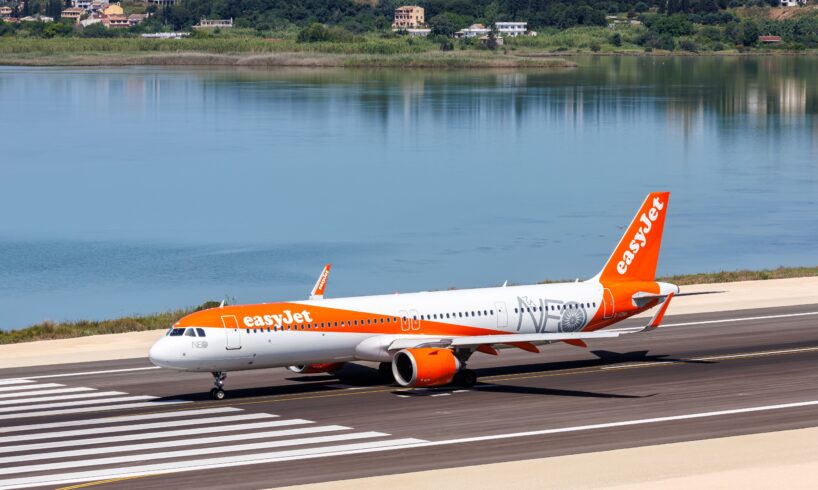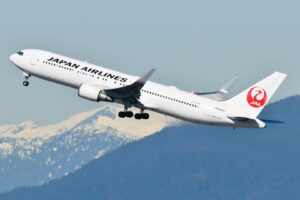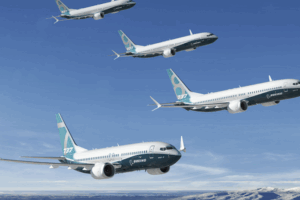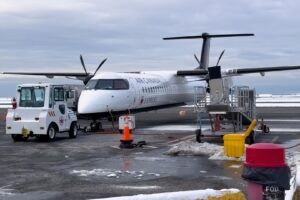
easyJet has been one of the rare cases of a low-cost carrier going through the lengthy and costly process of switching its fleet type. The airline, which began flying with Boeing 737s, switched to the Airbus A320ceo aircraft family in October 2002, when it ordered 120 A319ceo aircraft. Throughout the decade, as A319s began trickling in, with the first, registered as G-EZEA, arriving in February 2004, easyJet also adopted the larger A320ceo and A321ceo aircraft.
IATA/ICAO Code
U2/EZY (UK) |
EC/EJU (Europe) |
DS/EZS (Switzerland)
Year Founded
1995
While its adventure with the A321ceos was short-lived, which were acquired with the acquisition of GB Airways in 2008 and phased out within two years, the airline eventually adopted the A321neo, taking delivery of its first aircraft of the type in 2018. Since then, easyJet’s A321neo fleet has grown steadily, as has its route network with the largest A320neo family aircraft. Simple Flying explores easyJet’s A321neo routes in June.
Adding easyJet’s First Airbus A321neo
Photo: easyJet
easyJet’s journey with the A321neo began in May 2017, or 2002, if you consider the low-cost carrier’s initial Airbus order for 120 A319ceo, when the airline decided to upgauge 30 orders, converting them from the A320neo to the A321neo.
While it was quite an uptick, with Airbus saying that the airline went from an A320neo seating 186 passengers to the A321neo, welcoming up to 235, it made sense. According to the European manufacturer, the move was done “for growth at slot-constrained airports,” while the airline added that in addition to circumventing slot constraints, the A321neo would help the company manage its costs.
The airline welcomed the first A321neo on July 18, 2018. Johan Lundgren, the then-Chief Executive Officer (CEO) of easyJet, said that the larger aircraft would enable the carrier to deliver its strategy of securing and growing its number one position across Europe’s leading and slot-constrained airports.
“It will also provide easyJet with the lowest operating costs in the single aisle aircraft category, with unit cost savings which are estimated to be up to 9% better than an A320neo and around 21% better than an A319. And crucially, it will also bring significant environmental and operational benefits, which means we will be able to offer more seats and low fares to even more people travelling on Europe’s most popular leisure and business routes, whilst both reducing emissions and noise to mitigate our impact on the communities around the airports we serve.”
Confirming Further A321neo Fleet Growth
Photo: InsectWorld | Shutterstock
In December 2023, easyJet’s shareholders approved the airline’s order for up to 157 A320neo family aircraft, as well as 100 ‘purchase rights’ for the family’s aircraft. In addition, the airline converted another 35 planned A320neo deliveries into the A321neo.
easyJet argued that the order and the type conversion would provide it with an opportunity to grow capacity through a combination of incremental aircraft and upgauging, and replace older A319ceo, as well as half of the then-current A320ceo fleet. This would provide the “foundation for disciplined growth and bringing cost and sustainability improvements to the business.”
At the time, the low-cost carrier said that before the order, it already had an existing order book for 158 A320neo aircraft for up to FY29, which is the company’s fiscal period that ends on September 30, 2029. “With limited delivery slots in the market for narrow body aircraft until at least 2029, confirming this order now ensures easyJet has a supply of future delivery slots between FY29 and FY34 to retain its current scale through replacing aircraft leaving the fleet and this enables easyJet to execute its growth strategy,” easyJet stated.
As of today, easyJet has 19 A321neo aircraft, according to ch-aviation records. 11 are registered in the United Kingdom, while the remaining eight are assigned to easyJet’s subsidiary’s air operator’s certificate (AOC) in Austria, with the airline being officially known as easyJet Europe. According to the site, Airbus delivered easyJet’s last two A321neo aircraft on October 30, when the European plane maker handed over two A321neos, registered as OE-IUA and OE-IUB, to easyJet Europe. Another two A321neo aircraft should arrive in late 2025, ch-aviation estimated.
The site’s records also showed that easyJet, the UK-based airline, has stationed its A321neo aircraft at three airports across the country: Bristol Airport (BRS), London Gatwick Airport (LGW), and Manchester Airport (MAN). Meanwhile, easyJet Europe has two A321neo bases: Lisbon Airport (LIS) and Milan Malpensa Airport (MXP).
Photo: Great Circle Mapper
Related
Big Expansion: easyJet Adds 22 Routes From 12 UK Airports
They include services from Leeds/Bradford, London Southend, and Southampton.
easyJet’s A321neo Bases In The UK
Photo: Carlo Dedoni | Shutterstock
According to data from the aviation analytics company Cirium’s Diio Mi airline planning tool, easyJet has scheduled 149 weekly A321neo departures from Bristol, London-Gatwick, and Manchester in June, which excludes flights operated by easyJet Europe. Only one route has daily or more A321neo itineraries planned during the month, namely flights from London-Gatwick to Chania International Airport (CHQ).
In general, London-Gatwick is easyJet’s biggest A321neo base in terms of weekly departures (93) and the number of aircraft based at the airport (seven, per ch-aviation). easyJet UK has scheduled flights on 35 routes from the British capital’s second-busiest airport, with weekly frequencies ranging from one to daily, which, as mentioned above, is on the London-Gatwick to Chania route.
Other than that, except for flights to such destinations as Geneva Airport (GVA), Milan Linate Airport (LIN), Milan Malpensa Airport (MXP), and Paris Charles de Gaulle Airport (CDG), easyJet’s focus is on leisure destinations around the Mediterranean Sea or south of the body of water. This includes departures to Fuerteventura Airport (FUE), Lanzarote Airport (ACE), Marrakesh Menara Airport (RAK), Sharm el-Sheikh International Airport (SSH), and Tenerife South Airport (TFS). Considering that, historically, low-cost carriers have targeted leisure travelers, with the addition of easyJet running a holiday package business, its network hardly has any surprises.
Photo: Great Circle Mapper
From Manchester, which has two A321neo aircraft based at the airport, G-UZMF and G-UZMH, easyJet UK has scheduled 28 weekly departures, per Cirium’s Diio Mi. There are some differences to the airline’s network with the largest Airbus narrowbody aircraft – except for the A321XLR, which easyJet does not have yet – from London-Gatwick and Manchester, such as flights to Barcelona-El Prat Airport (BCN).
Photo: Great Circle Mapper
easyJet UK has also based two A321neo aircraft in Bristol, G-UZMB and G-UZMG, per ch-aviation. Similarly to Manchester, the airline has scheduled 28 weekly departures with the type in June. However, the carrier’s A321neo network, unlike that at the airport located in the north of England, includes flights to such destinations as Milas–Bodrum Airport (BJV), Corfu Airport (CFU), Dubrovnik Airport (DBV), Rome Leonardo da Vinci Fiumicino Airport (FCO), and others.
Photo: Great Circle Mapper
A321neo Bases in Lisbon And Milan
Photo: Markus Mainka | Shutterstock
Outside of the UK, easyJet has two bases with A321neo aircraft, which are operated by its Austrian subsidiary, easyJet Europe. In Lisbon, Portugal, the low-cost carrier has two aircraft of the type: OE-ISE and OE-IUA, per ch-aviation records.
Cirium’s Diio Mi showed that easyJet has scheduled easyJet Europe to operate 52 weekly flights to a variety of destinations, such as the six weekly departures to Madeira Airport (FNC) and London-Gatwick. Unlike London or Manchester, Lisbon is more of a leisure destination in itself, attracting tourists from all over Europe who are looking for guaranteed sunshine. As a result, unlike the three UK airports’ A321neo networks, easyJet’s routes from the Portuguese capital include some connections to the north, including to Switzerland, where the low-cost carrier has a significant presence.
Photo: Great Circle Mapper
Milan-Malpensa is easyJet group’s second-largest A321neo base, with the airline assigning six aircraft: OE-ISB, OE-ISC, OE-ISD, OE-ISG, OE-ISH, and OE-IUB, to the Italian airport. easyJet Europe’s weekly departures from Milan-Malpensa number 81, with three routes with daily or more flights, according to Cirium’s Diio Mi. This includes flights to Athens Airport (ATH), Marrakesh, and Sharm el-Sheikh, while overall, easyJet Europe has scheduled A321neo flights on 29 non-stop routes. The route network includes six domestic flights to such airports as Catania Airport (CTA) or Olbia Costa Smeralda Airport (OLB), or some longer itineraries, such as flights to Keflavik Reykjavik International Airport (KEF).
Photo: Great Circle Mapper
Analysis of forward-looking data showed that easyJet could also be plotting A321neo bases at Berlin Brandenburg Airport (BER) and Paris-Charles de Gaulle. In November, for example, easyJet has scheduled eight A321neo routes from Berlin-Brandenburg, including to London-Gatwick, while in January 2026, the A321neo route network from Paris-Charles, which in the previous months was only connected to its other bases across Europe, could expand to eight destinations, and to 11 by February 2026.
The expansion of A321neo bases would coincide with Airbus handing over new aircraft to the airline, with ch-aviation estimating that easyJet’s next A321neo deliveries would happen in October, November, January 2026, and then in March 2026. The European plane maker should deliver another six aircraft of the type between April 2026 and December 2026, according to ch-aviation’s estimates. At the same time, the delivery schedule could be pushed back, considering that the plane maker has admitted that it would remain behind the contractual delivery days for several years, including due to delays related to receiving CFM International LEAP-1A engines, which will continue to power easyJet’s A320neo aircraft following the two parties confirming an engine order on January 2024, a month after the low-cost carrier’s shareholders approved the 157 A320neo aircraft order.






